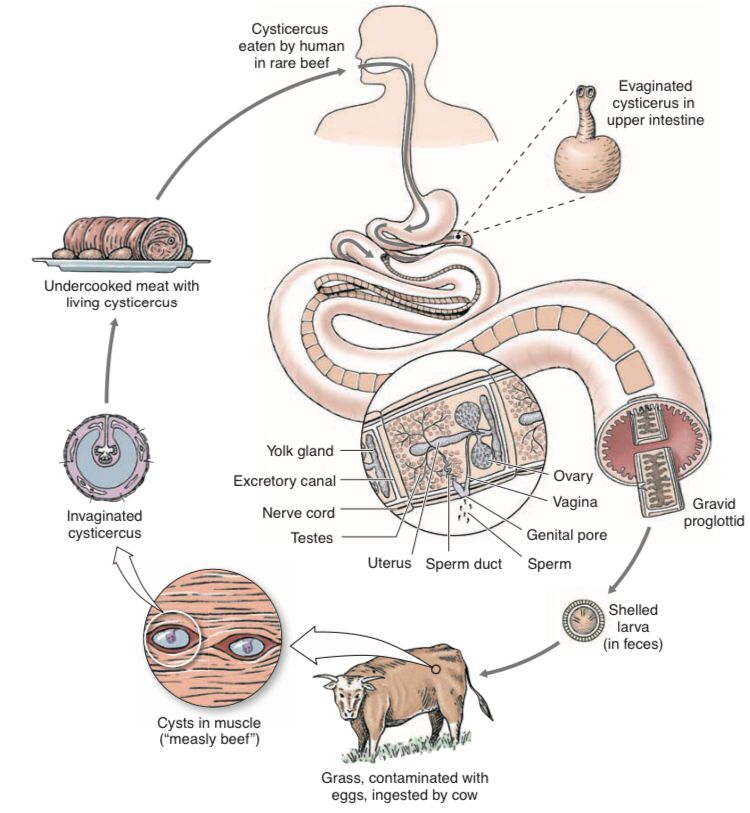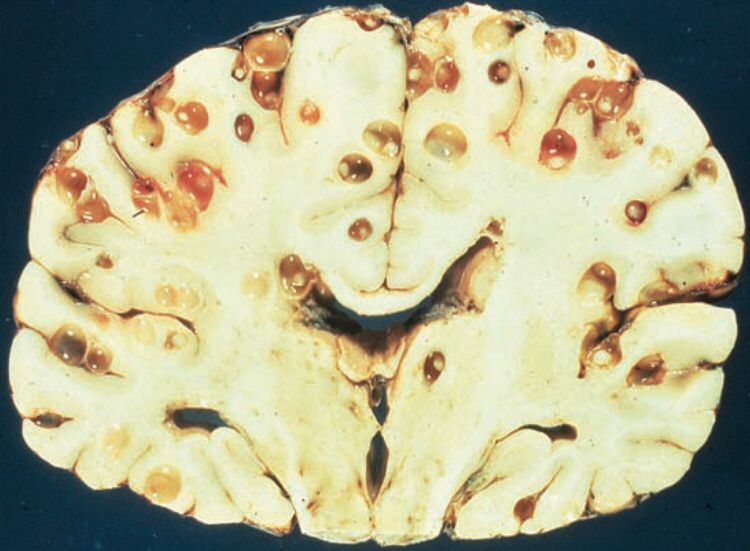Taenia saginata (Gr. tainia, band, ribbon) is called the beef tapeworm, but it lives as an adult in the human intestine. Juvenile forms occur primarily in intermuscular tissue of cattle. A mature adult may reach a length of 10 m or more. Its scolex has four suckers for attachment to the intestinal wall, but no hooks. A short neck connects the scolex to the strobila, which may have as many as 2000 proglottids. Gravid proglottids bear shelled, infective larvae which become detached and pass in feces. Although tapeworms lack true metamerism, there is repetition of the reproductive and excretory systems in each proglottid. Excretory canals in the scolex are continued the length of the body by a pair of dorsolateral, and a pair of ventrolateral, excretory canals.

These paired canals are connected by a transverse canal near the posterior end of each proglottid. Two longitudinal nerve cords from a nerve ring in the scolex also run back through each proglottid . Attached to the excretory ducts are flame cells. Each mature proglottid also contains muscles and parenchyma as well as a complete set of male and female organs similar to those of a trematode. In this group of tapeworms, vitellaria are typically a single, compact vitelline gland located just posterior to the ovaries. When gravid proglottids break off and pass out with the feces, they usually crawl out of the fecal mass and onto vegetation nearby. There they may be eaten by grazing cattle. A proglottid ruptures as it dries, further scattering the embryos on soil and grass. Embryos may remain viable on grass for as long as 5 months.

two other proglottids also shown.
Shelled larvae (oncospheres) swallowed by cattle hatch and use their hooks to burrow through the intestinal wall into blood or lymph vessels and finally reach voluntary muscle, where they encyst to become bladder worms (juveniles called cysticerci). There the juveniles develop an invaginated scolex but remain quiescent. When raw or undercooked “measly” meat is eaten by a suitable host, the cyst wall dissolves, the scolex evaginates an attaches to the intestinal mucosa, and new proglottids begin to develop. It takes 2 to 3 weeks for a mature worm to form. When a person is infected with one of these tapeworms, numerous gravid proglottids are expelled daily, sometimes even crawling out the anus. Humans become infected by eating rare roast beef, steaks, and barbecues. Considering that about 1% of American cattle are infected, that 20% of all cattle slaughtered are not federally inspected, and that even in inspected meat one-fourth of infections are missed, it is not surprising that tapeworm infection is fairly common. Infection is easily avoided when meat is thoroughly cooked.
Adult Taenia solium (Gr. tainia, band, ribbon) live in the human small intestine whereas juveniles occur in the muscles of pigs. The scolex has both suckers and hooks arranged on its tip, the rostellum. The life history of this worm is similar to that of the beef tapeworm, except that people become infected by eating insufficiently cooked pork. Taenia solium is much more dangerous than T. saginata because cysticerci, as well as adults, can develop in humans. If someone accidentally ingests eggs or proglottids the liberated embryos migrate to any of several organs and form cysticerc . The condition is called cysticercosis. Common sites are eyes and brain, and infection in such locations can cause blindness, serious neurological symptoms, or death.


Adult Diphyllobothrium (Gr. dis, double, + phyllon, leaf, + bothrion, hole, trench) live in the intestines of humans, dogs, cats, and other mammals; immature stages develop in crustaceans and fish. With a length up to 20 m, it is the largest cestode that infects humans. Fish tapeworm infections can occur anywhere in the world where people commonly eat raw fish; in the United States infections are most common in the Great Lakes region. In Finland the worm can cause a serious anemia not apparent in other areas.
Useful External Links


